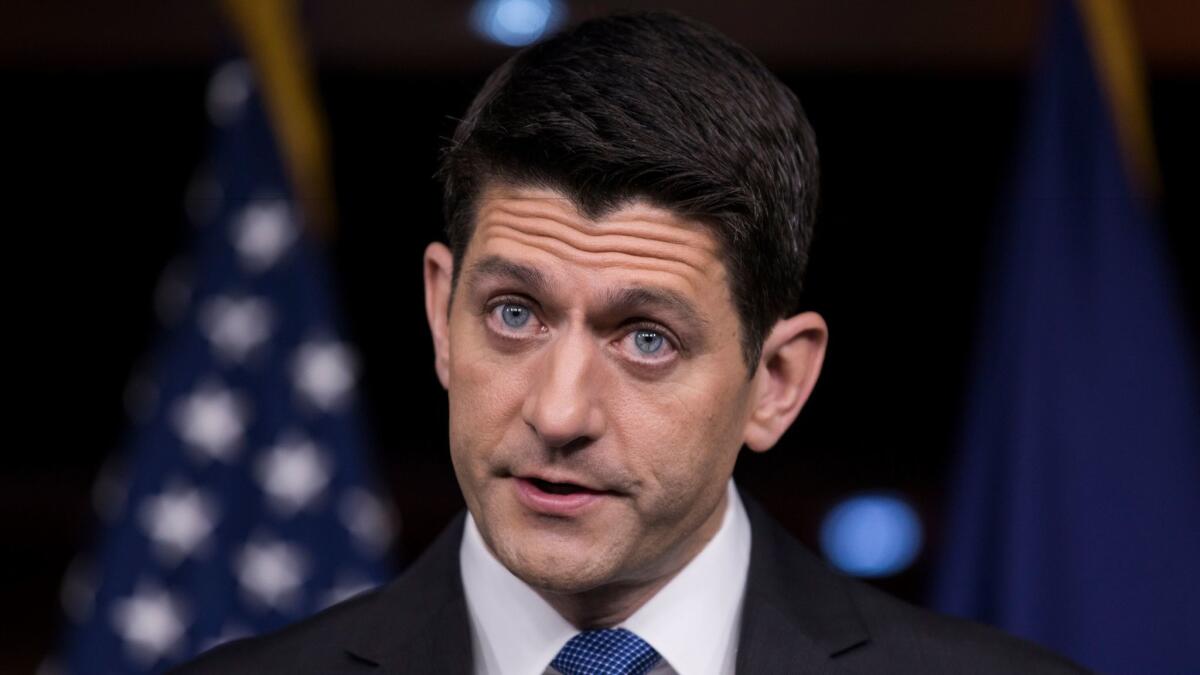Column: An attack on abortion rights and a handout to the rich: The Republicans’ new plan for repealing Obamacare

Congressional Republicans who have visited their home districts over the last few weeks have gotten a faceful of constituent rage about their plans to eviscerate the Affordable Care Act, which brings health coverage to more than 20 million Americans. If past is prologue, those heading home now for the Presidents Day recess are likely to feel a lot more heat.
That may be why House Republicans this week rushed out a “policy brief” on “Obamacare Repeal and Replace.” Unfortunately for the poor souls who will be meeting with constituents, the brief answers none of the key questions about the GOP’s plans for the ACA. It doesn’t certify that, whatever those plans are, they would avoid throwing millions of Americans out of the insurance pool, or that they would save money. It doesn’t give many specific details. It doesn’t say anything about the costs of its proposals, or how those costs would land on Americans of various income levels. It’s backed up by claims about the ACA that have been shown to be wrong or deceitful, or both.
Data ... provide strong evidence that premium increases did not cause dramatic enrollment declines, much less spark a death spiral.
— Matthew Fiedler, Brookings
The appearance of the policy paper also is important because of rising disquiet among insurers about the future of the ACA individual marketplaces. Earlier this week, Humana said it would withdraw from the market in 2018. Mark Bertolini, the chairman and CEO of Aetna, declared that the marketplaces were experiencing a “death spiral,” which feeds into the GOP’s talking point that the ACA is doomed and therefore warrants repeal.
The insurers’ announcements deserve some scrutiny. Humana was a relatively small player in the ACA, with only about 152,000 customers in 11 states enrolled in ACA plans. As David Anderson of Duke University observes, its pricing strategy was not especially competent, tending to discourage healthy individuals from signing up while leaving its plans “attractive to an older population that is likely to be sicker.” Hence, losses.
As for Aetna, its assertions about the ACA have been a model of public dishonesty. As we reported here and here, Aetna’s announcement in August that it was withdrawing from 11 of the 15 states where it offered ACA plans because it was losing money was deceitful. That was the conclusion of a federal judge, who found last month that the real reason for its withdrawal was to gain an advantage over the government in the latter’s lawsuit to block its merger with Humana. (The judge rejected the merger.) In fact, Aetna was turning a profit in at least some of the states that it exited.
Bertolini’s assertion notwithstanding, there is no evidence that the ACA marketplace is experiencing a “death spiral,” which results when price increases drive away more and more healthy customers, leaving sick individuals in the pool and forcing prices inexorably higher. The evidence is to the contrary: Matthew Fiedler of the Brookings Institution reports that “data on final HealthCare.gov sign-ups provide strong evidence that premium increases did not cause dramatic enrollment declines, much less spark a death spiral.” That’s understandable, since more than 85% of ACA customers are eligible for subsidies that in some cases reduced their real premium increases to zero.
Insurers have been making clear that it’s GOP dithering over the ACA that is contributing to their uneasiness. The death spiral hasn’t emerged yet, but as insurers ponder whether to participate in the individual exchanges in 2018 — a decision that many must make by April — the GOP’s lack of planning could produce it.
Now to the GOP repeal and replace proposal. In major ways, the proposal would hammer low-income Americans with higher healthcare costs while providing a greater cushion, even a handout, to the wealthy. Here’s how:
Block-granting and capping Medicaid. The Republicans give this the deceitful label of “modernizing” Medicaid, which provides ACA coverage to as many as 11 million Americans. Under the ACA, the federal government’s share of the expansion cost — 95% this year — will be ratcheted down to 90% in 2020 and beyond.
The GOP plan proposes to phase out this program entirely by eventually reducing the federal match to the same level as the match for traditional Medicaid, which covers low-income families, mostly those with children. That match varies by state but can be as low as 50%. The GOP also would convert Medicaid funding to a block-grant — a set sum for states to spend as they choose.
Block-granting Medicaid, a hobby horse of House Speaker Paul Ryan (R-Wis.) and Tom Price, the new secretary of Health and Human Services, would guarantee drastic cuts in funding for the program. That’s because the formulas proposed by the Republicans would allow the grants to grow at a lower pace than the current system, so the funding relative to needs would deteriorate over time. A study by the Urban Institute of an earlier proposal by Ryan found that it would throw as many as 21 million people off traditional Medicaid.
Amazingly, the GOP depicts these changes as an attempt to redress the “unfairness” of providing a higher federal match for Medicaid for “able-bodied adults” — that is, those receiving Medicaid via the ACA --than it does for the aged, blind and disabled, and children. The ACA Medicaid expansion covers adults and families up to 138% of the federal poverty line, or $33,600 for a family of four. These are the people the GOP proposed to throw off Medicaid — not even including those under traditional Medicaid whose benefits would necessarily be slashed. They call this “putting Medicaid on a budget,” but it really means wrecking the household budgets of the neediest Americans.
Premium subsidies that leave middle- and low-income families behind. The GOP proposes to continue offering tax subsidies to cover premiums, but converts them from income-based to age-based. Let’s be plain: The idea of matching tax credits to age makes no sense; it means providing a bigger subsidy to, say, Bill Gates (age 61) than to a husband and wife in their 30s with $50,000 income and two kids. Although healthcare spending tends to rise with age, older Americans tend to have more resources, too. The governing factor in the affordability of health coverage is household income.
The GOP asserts that eliminating the income test will “help simplify the verification process,” but that’s a marginal gain. It claims that basing the subsidy on age rather than income will avoid the “labor market distortions and perverse incentives” of the ACA. To support this, it misrepresents a Congressional Budget Office study about the job effects of the ACA. The GOP implies that the study pointed to “lost hours” as if these were jobs lost involuntarily; in fact, the CBO projected that by severing the link between employment and insurance, the law would free more people to voluntarily leave employment to do something else with their lives, whether caring for family members, starting entrepreneurial companies, or retiring.
That’s exactly what has happened: Since the ACA, full-time employment in the U.S. has increased, as has voluntary part-time labor. The Republican party used to think that eliminating the “job lock” of employment-based insurance was a good thing because it increased individual choice. Now they call it a “distortion” of the labor market.
An assault on abortion rights. Buried in the GOP plan is a single line specifying that its premium subsidy won’t be “available to be used for plans that cover abortion.”
This is a flagrant and despicable attack on individual choice. It represents the endorsement of sex discrimination as an element of our healthcare system, after passage of the Affordable Care Act started to wipe it out by requiring that pregnancy and maternity benefits be covered by every insurance policy. Nor is it about using federal dollars for abortions—that’s already covered by the egregious Hyde Amendment, which would remain in effect and, as Jordan Weissmann of Slate observes, already prevents abortions from being covered by Medicaid. The new proposal would forbid using subsidies on plans that merely offer abortion coverage, even if it’s not used by the enrollees.
Health Savings Accounts for the rich. The GOP proposes to nearly double the maximum contributions to these accounts, which allow for tax-advantaged spending on medical costs, to $6,550 per year for individuals and $13,100 for families. We’ve reported before on how these plans essentially are bounties for the wealthy.
The tax benefits of HSAs grow along with taxpayers’ liabilities; low-income families with low tax bills that already struggle to pay for medical care won’t find it any easier to scrape together money to fund their accounts. For the wealthy, however, they’re another tax break to fatten their retirement nest eggs. Meanwhile, they peel healthier individuals and families out of the overall risk pool, making insurance more expensive for everyone else.
The fantasy of high-risk pools. Another hobby horse of Ryan’s, high-risk pools aim to serve people with chronic diseases or catastrophic illnesses. The idea is that insurance for the rest of the individual market will be cheaper, because it won’t be subsidizing the terribly ill. As we have reported in the past, high-risk pools were tried by 35 states prior to the ACA. They don’t work. They were vastly expensive and deeply underfunded; as a result, most such pools imposed ruinous premiums on their enrollees and subjected them to sky-high deductibles, benefit limits, enrollment caps, coverage exclusions, and waiting lists.
The GOP policy paper says “the next generation of high-risk pools” will be funded by federal “innovation grants” to avoid but, tellingly, is silent on how much, even though the funding level is the key. One study placed the cost at $178 billion per year, far more than the Republican Congress is likely to allocate.
Instead, the paper asks for our trust: The innovation grants, it says, “are designed to help vulnerable patients. Why would anyone allow them to potentially harm the very patients they are intended to help?”
Franklin Roosevelt had an answer to this bid for trust. At the New York State Democratic Convention in 1936, he ridiculed the GOP claim that it believed in Social Security, in job creation and in saving homes. “Cross our hearts and hope to die [the Republicans claim], we believe in all these things…. Just turn them over to us. We will do all of them, we will do more of them, we will do them better; and, most important of all, the doing of them will not cost anybody anything.”
FDR warned his audience that “the first essential of doing a job well is to want to see the job done.… The Republican leadership is against the job’s being done.”
Keep up to date with Michael Hiltzik. Follow @hiltzikm on Twitter, see his Facebook page, or email [email protected].
Return to Michael Hiltzik’s blog.
UPDATES:
8:09 p.m.: This post and headline have been updated to include the GOP plan’s attack on abortion rights.
More to Read
Inside the business of entertainment
The Wide Shot brings you news, analysis and insights on everything from streaming wars to production — and what it all means for the future.
You may occasionally receive promotional content from the Los Angeles Times.











